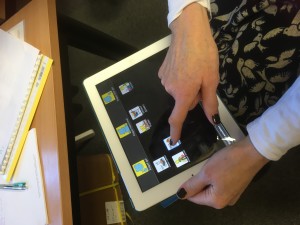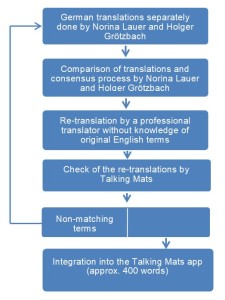We are delighted that ‘Talking Mats in German’ is now available in the Digital version and includes the latest technical and symbol upgrades. These upgrades are also now included in the English version.
Please click on this link to find out about all the upgrades.
We are very grateful to Prof Norina Lauer for sending us this blog which explains how ‘Talking Mats in German’ has been developed.
In 2016 Prof. Dr. Norina Lauer, a German professor for speech language therapy contacted Joan Murphy from Talking Mats because she was initially interested in the digital version for goal setting with people with aphasia. We found out that it would be interesting to have a German version of the app. So we started a project for translating Talking Mats into German. Prof. Dr. Norina Lauer managed the translation process. The project was financially supported by a German health insurance “BKK Dachverband” in cooperation with the German aphasia self-help organization “Bundesverband für die Rehabilitation der Aphasiker” (www.aphasiker.de). The translations were performed in a special scientific procedure to make sure that they match the English terms.
What did we do?
Norina Lauer and her colleague Holger Grötzbach independently translated the English terms into German. Subsequently these translations were compared and the differing terms were discussed until a consensus was reached. The agreed translations were given to a professional translator who only got the German words and the corresponding pictures. She re-translated the terms into English and these re-translations were checked by Talking Mats if they were in accordance with the original English terms. For those terms that did not match, the process started again until all terms matched the original English terms (figure 1 shows the translation process). This process was performed for all topics of the app. So we have the complete Talking Mats app in German now.
Figure 1
So what’s next?
Norina Lauer completed the foundation training and the accredited training in 2017. In October 2017 she performed her first foundation training for 6 of her SLT students. One of these students will do her bachelor thesis about the German app version in 2018. Under accompanying consultation of Norina Lauer the student will perform two workshops for people with aphasia. In these workshops they will practice doing Talking Mats and afterwards evaluate the app concerning its content and practical use. For the evaluation we are planning a short questionnaire and a focus group.
It has been a delight to work with Norina and we look forward to hearing the results of her student’s project.
If you already have the Digital Talking Mats make sure you upgrade to get all the new features. The German version with the upgraded is now available from the App store, Google Play (Free and Lite versions) or purchase the full version from our website .
Get involved in choosing a Communication Access UK Symbol , and set the standards to go with it!
In early 2017 Communication Matters[1] found out that –
- People with communication difficulties don’t always get the support they need in the community.
- People would like a Communication Access symbol in the UK. Businesses already use some symbols e.g
A small group of people were asked to choose a symbol to represent Communication Access. 2 ideas were very popular. For an organisation to display this communication symbol it will mean the staff have been trained to support communication and that the business meets certain standards
Communication Matters now want to hear from more people, with and without communication difficulties.
To have your say about 1) the symbol and 2) the standards to support communication follow this link. http://www.talkingmats.com/wp-content/uploads/2017/12/Communication-Access-UK-Symbols-and-Standards.pdf You will find the symbol choice and a Talking Mat to decide what is important to include in the Communication Access Standards. Send your responses to Communication Matters
Email : admin@communicationmatters.org.uk
Or post : Communication Matters, 3rd Floor, University House, University of Leeds, LEEDS, LS2 9DF
[1] http://www.communicationmatters.org.uk/
Do you need training to use Talking Mats ?
Talking Mats is an effective but deceptively simple tool so a question we are often asked is do you need training to use it. Communication and supporting people with communication difficulties is a complex process and Talking Mats is based on a number of research projects which examined who could use Talking Mats, and how best to use it in different situations. It is therefore important that the integrity of the Talking Mats model is maintained and that Talking Mats training teaches the principles developed from our evidence base.
All our trainers are registered with Talking Mats and provide high quality training based on robust research findings. Only trainers accredited by Talking Mats are eligible to train others.
Some of these principles include:
- Understanding who can and who cannot benefit from using Talking Mats
- Asking open questions
- Handing over control
- Pacing
- Maintaining neutrality
- Interpreting additional information including both non-verbal and verbal information
- Matching the top scale to the question or view being explored
- Presenting the options in an order that maximises the individuals ability to respond by using our model which focuses on concrete to abstract symbols
- Monitoring language complexity and topic sensitivity
All our training courses include hands-on practice and video examples as well as reflection on all these aspects of using Talking Mats
The techniques used in Talking Mats accord with best practice guidance in semi –structured interview techniques including:
- being clear in what you want to find out and using open questions
- enabling elaboration in whatever form is appropriate
- planning in advance but in a context that is flexible and can respond to the dynamics of the conversation
- being cognisant of the influence of the environment
- taking time to establish engagement and rapport
- being non-judgemental
- supportive of periods of silence
- ensuring there is a summary at the end so that both parties agree on what was said .
So whilst Talking Mats may seem simple, it is not simplistic. The listener is creating a space that enables the thinker to think and express themselves. Training gives the listener time to reflect on the components of an effective Talking Mats conversation and identify which ones they are already skilled in and which ones they need to develop further. There are no short cuts to reflective practice training and we know Talking Mats foundation training has impact. Time and time again people who thought they knew about Talking Mats reflect and say things like ‘I got so much more from this training than I expected’ or ‘ I now see I can use Talking Mats for so many different conversations not just ’ I like’ , ‘I don’t like’ ‘or ‘I have been using Talking Mats but now feel much more confident to use it and to make my own submats’

This is why we put so much emphasis on training. We have developed our successful “Train the trainer” scheme to ensure that quality is maintained and reflective practice maintained. If Talking Mats is passed by word of mouth then key aspects of the framework are missed and/or misinterpreted which in turn lessens its effectiveness and impact.
People who come on training are often excited, want to tell colleagues and share it with others. Demonstration and sharing is fine, but it is important to be aware of the difference between sharing and training.
Sharing can often be appropriate especially when there is a team of people supporting the person or parents are keen to see how it works. You can show someone how to use a Talking Mat about a specific conversation. We call this a ‘demonstrating model’. It is helpful to give the listener the words to say to go with it. That way you are enabling other colleagues or family members to have an effective but specific conversation only.
If they then want to use it for other conversations we would strongly recommend they go on to attend the training. Attending a foundation course will enable them:
- to get more out of the technique
- to understand more about their own communication
- to become creative in their use of Talking Mats whilst still adhering to the research principles
- to be able to create their own mats or explore a topic in more depth using submats
So do you need training to use Talking Mats ? The answer is a resounding yes . Training supports you to be an effective Talking Mats listener and get the most out of this versatile communication framework. So if you have not attended a course check out our course opportunities.
 Online training login
Online training login 






